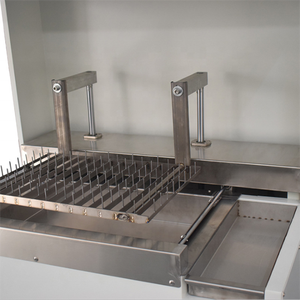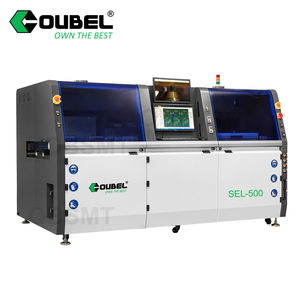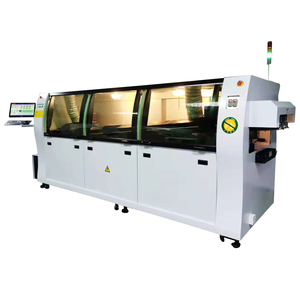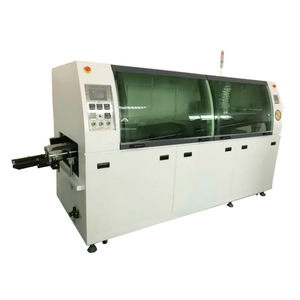
All categories
Featured selections
Trade Assurance
Buyer Central
Help Center
Get the app
Become a supplier

(2891 products available)






































A wave soldering machine is a device that performs wave soldering, which in turn is a production process. The process is used extensively in the electrical and electronics manufacturing industry. Wave soldering, a vital method of soldering printed circuit boards (PCBs), accommodates large batches and provides solid connections to numerous components.
The different types of wave soldering machines have been categorized based on the wave generated, soldering method, and production volume requirements.
Conventional machines use a pump-generated wave of molten solder to coat the PCB surfaces where soldering is needed. The wave oscillation forces the solder into the PCB holes and onto surface mount device (SMD) pads, creating a reliable joint. This type is primarily for through-hole technology (THT) components but can be combined with other techniques for flexibility.
Selective machines offer better functionality than conventional ones—the systems thoughtfully deposit solder only in specific areas of a PCB where required. This controlled approach minimizes soldering defects, reduces solder consumption, and positively impacts overall production efficiency. Hence, it is suitable for complex PCBs with densely populated areas.
As the name suggests, these machines are automatic and feature full automation concerning PCB transport, solder application, and process monitoring. This automation boosts productivity because manual labor is largely offset, cutting down inconsistencies and errors. More so, these machines suit mass production, thus making great efficiency gains.
These are smaller machines and, as the name says, are manually operated. This means that a manual wave soldering machine contains a solder pot with a pump to generate the wave. In many cases, they are portable and allow quick setups for low-volume production or prototyping. While they lack the output capacity of larger machines, they serve modest production needs effectively.
This type is closely related to wave soldering but uses hot air to level the solder on the PCB rather than a wave. It has an advantage when solder needs to be evenly redistributed across the board to prevent bridging or insufficient solder. Hot air solder levelling systems are mostly used for surface mount technology (SMT) components requiring extra solder tolerance.
Wave soldering machines are quite popular among people in the medical and healthcare sectors. They are vital in numerous industries for soldering components on PCBs. As for their role, wave soldering machines enhance efficiency and consistency when soldering, positively impacting operational effectiveness.
For consumer electronics, wave soldering is primarily for products such as smartphones, televisions, and home appliances. It provides a means to solder both through-hole and surface-mount components to complex multilayer PCBs. Such capability enables mass production while maintaining high quality, making these machines ideal for meeting consumer demand.
Automotive industries use wave soldering in their manufacturing process of PCBs for electronic control units (ECUs), sensors, and other components. Wave soldering machines contribute to producing reliable solder joints that can withstand automotive conditions such as extreme temperatures and vibrations.
Wave soldering is used for high-density interconnects and PCBs in telecommunications equipment such as routers, switches, and base stations. Selective wave soldering systems have a special soldering capability for densely populated boards by precisely controlling solder deposition. This detail improves the soldering quality and reduces bridging, a hallmark of high-density board issues.
Systems, controls, and devices in industrial manufacturing and automation rely on wave soldered PCBs. These PCBs carry out soldering for components like relays, capacitors, and connectors to ensure joint reliability under heavy loads. Thus, wave soldering ensures that the equipment operates reliably and with minimum downtime.
Medical device manufacturing requires strict standards. This feature makes wave soldering particularly useful. Wave soldering machines are responsible for soldering PCBs used in diagnostic equipment, monitors, and implantable devices. Due to its precision and ability to handle complex assemblies, selective wave soldering is crucial for ensuring that solder joints endure critical conditions while being safe and reliable.
Understanding the technical specifications is vital in determining any wave soldering machine's performance, efficiency, and suitability for operations. They are components that differ across models and types of wave soldering machines due to their distinct industrial applications.
Solder Pot Capacity
The soldering machine's solder pot capacity greatly influences its processing capability. Bigger pots can handle larger offerings since they can contain more solder, while smaller pots are more efficient for low-volume tasks. Generally, the standard capacity ranges from 10kg to 25kg.
Conveyor Speed
An adjustable conveyor speed allows the control of the wave soldering duration. This feature varies among machines and, therefore, impacts the soldering quality and output because slower speeds improve soldering for a more thorough joint, while faster speeds suit high-volume productions.
Temperature Control
Precise temperature control is vital for wave soldering because it aids in maintaining solder molten consistency and ensures proper PCB heating. Multiple temperature zones give the machine this ability to optimize solder behavior throughout the process.
Board Support
Supports such as mesh belts, pallets, or screens maintain the PCB during soldering by ensuring stability and preventing warpage. The selectability of board support designs enable optimization according to the PCB configuration and size the machine will handle.
Wave Height Adjustment
This feature allows the adjustment of wave height for PCB dependency. Thinner PCBs need lower wave heights to avoid damage, while thicker ones can withstand higher solder amounts. The variability comes in handy when soldering a range of PCB designs.
The wave soldering machine requires installation and setup to kick off the soldering process. A properly done setup is crucial for an effective soldering operation and optimal functioning of the soldering machine.
The Machine
The first step is selecting installation sites for wave soldering machines, considering factors such as accessibility, power supply, and ventilation. The machines have to be level to ensure consistent soldering results.
Conveyor Configuration
Conveyor configuration is the next installation step. The conveyor components need to be assembled and aligned properly. Proper alignment is critical for the PCB movement during this phase to ensure it is steady and accurate throughout the soldering process.
Waves and Solder Pot
The next installation phase involves configuring waves and solder pots. The solder pot has to be filled with appropriate solder alloy after the wave-generating mechanism is configured. The wave height and pump settings also need to be adjusted according to the required specifications.
Temperature Settings
Set the temperature of different zones appropriately. Refer to the specific solder alloy and PCB material to achieve the right temperature for soldering. Proper zoning temperature is critical in preventing thermal damage to components and ensuring solders are correctly bonded.
Testing
The last installation step is the testing phase. Carry out a performance test to check whether the machine solder properly. This initial test helps in identifying issues and fine-tuning any necessary settings before actual production commences.
PCB has to go through wave soldering machines to have components soldered. It is crucial for users to understand the operating procedure for ideal solder joints and machine functioning.
Preparation
Genuine preparation involves cleaning and inspecting the PCBs before they are put into the soldering machine. This cleaning procedure eliminates any contamination that might exist, such as dust or residue. Preheating also helps in soldering by heating the PCB to the optimum temperature range. This range prepares the surface and reduces thermal shock on the components during soldering.
Solder Application
Owner loads the prepared PCB onto the conveyor belt that transports the machine. Solder waves coat the components and pads of the PCB as the conveyor moves it through the wave. The wave's height and speed govern the amount of solder applied. Therefore, these two factors should be set to suit the PCB design and the components used.
Soldering Process
After coating, the wave soldering process begins. The conveyor then carries the PCB through a molten solder wave where solder is applied to both sides of the PCB. This process ensures that all areas needing solder get soldered.
Cooling
Cooling follows soldering after the soldering process. In other words, the joints will have to solidify to form strength connections between the solder and the components. This is also a stage where the solder solidifies and will be used to support the soldered components and provide electrical connections. During this phase, cooling time depends on the solder alloy and board mass.
Inspection
Normal inspection checks whether the solder joints are visually looking okay and whether each condition is conforming to the required standard. There are automated optical inspection (AOI) systems for this purpose. These systems can quickly and efficiently evaluate solder joint quality and identify defects such as insufficient solder, solder bridging, and component misalignment.
Maintenance and repair can prolong wave soldering machines and help maintain them at their optimal level. Regular maintenance of machines that are very critical to industries affected by the larger industry keeps them running. It is thus important for any business to take care of the machines so that they do not go out of business.
Daily Maintenance
Daily maintenance involves cleaning the solder pot and wave generation components. Accumulated dross in the solder pot inhibits solder joint quality. Daily cleaning eliminates dross build-up and allows for heat distribution and solder alloy integrity. Inspect for signs of wear or damage on major components like pumps and nozzles. Look for worn-out parts that affect performance.
Lubrication
Lubrication follows daily maintenance. Proper lubrication reduces friction and wear on mechanical parts. It also minimizes the machine's noise and extends its operation life. Utilize lubricants recommended by manufacturers and apply them sparingly to prevent dust accumulation and ensure smooth component movement.
Periodic Checks
Besides daily maintenance, there has to be maintenance done periodically. For instance, solder pots have to be examined for corrosion or degradation. Constant use leads to such a possibility. They must then be replaced to avoid solder contamination. Can also have cooling systems scrutinized regularly for efficiency to prevent overheating of solder pots.
Software Updates
For wave soldering machines, software plays an increasing role because it often integrates automation. They, therefore, need to always keep the machine's software updated to have the latest functionalities and optimizations for soldering. Follow the manufacturer's guidelines on wave soldering machine software updates to reduce their chances of burning out.
Repairs
Repairing wave soldering machines requires having the right repair type handy. Solder pump failure, which is a common problem in machines, may produce inconsistent solder application or no solder output at all. This machine will need to be opened, and the pump itself will have to be examined to fix this issue. Either the wear parts will be replaced, or the entire pump will be replaced.
The soldering joint on soldering machines determines the quality of wave soldering machines. Inadequate quality will lead to solder bridging or insufficient solder, which can cause all sorts of problems, such as system failure. Thus, it is imperative to try and understand various quality-related parameters, such as those below, since they impact wave soldering machines' performance.
Solder Joint Quality
Solder joint quality is among them. Good-quality solder joints must be mechanically strong and electrically conductive. There should also be no defects like bridging or cold solder joints. Various quality checks can be employed, including visual inspection, automated optical inspection (AOI), and X-ray analysis.
Component Integrity
Wave soldering machines need to be able to maintain sensitive electronic components without damaging them. For instance, excessive heat or solder exposure can cause component failure. One way to avoid this is by fitting the soldering machine with some heat sinks to help mitigate this heat transfer to critical components during soldering.
Uniformity Across Production
The quality of solder joints varies when wave soldering machines are used in production. This uniformity is critical in reliability and performance. The wave soldering machine has to have all its processes tightly controlled to ensure that every joint soldered has the same quality. Consistent temperature, solder application, and PCB support are among the factors necessary for achieving uniformity.
Wave soldering machines incorporate important electrical and mechanical safety features into operating practices. These considerations ensure that everyone working with or near these machines is protected from the potential hazards associated with soldering operations.
Protective Covers
Wave soldering machines come with protective covers around the solder wave and solder pot areas. This minimizes contact with molten solder, which can cause serious burns. These covers should be maintained to prevent accidental exposure by employees.
Emergency Stop Buttons
Machines have emergency stop buttons fitted in easily accessible locations to allow quick machine stopping in an emergency. These buttons must be checked regularly so there is no downtime and little safety risk.
Proper PPE
Personal protective equipment (PPE) use is mandatory. PPE requirements will normally include heat-resistant gloves and safety glasses. Their purpose is to protect workers from potential hazards like burns or splashes of molten solder. Other PPE that should be worn are anti-static garments and ESD wrist straps to prevent damage to sensitive electronic components.
Proper Training
All wave soldering machine trainees must be trained regarding its operation, maintenance, and safety practices. They have to be trained in the importance of PPE, machine hazards, and emergency procedures. Machines to have clear operating instructions posted on them to serve as guides when performing tasks.
A1: Wave soldering is commonly used in electronics manufacturing to solder components onto printed circuit boards (PCBs). It provides an efficient means of soldering both surface mount and through-hole components on PCBs. This system works well for high-volume production runs of standard electronic assemblies since it can rapidly process large quantities of PCBs.
A2: Wave soldering is highly efficient, especially for large production runs, as it automates the process of applying solder to multiple joints simultaneously. Hand soldering, though, is labor-intensive and more suited for small-scale production or repair work. It allows for personal adjustments and fixes that are difficult to make in large wave soldering machines.
A3: Wave soldering machines require cleaning of the solder pot, inspection of key components like pumps and nozzles, and lubrication of moving parts. In addition, any accumulated dross in the solder pot has to be eliminated to ensure heat distribution and alloy integrity. Also, there can be cooling and monitoring machine wear to make sure that proper functioning is there and optimal performance caught for.
A4: Yes, many modern wave soldering machines are compatible with lead-free solders. They can use various solder alloys, including lead-free formulations. This usage helps meet environmental regulations like RoHS (Restriction of Hazardous Substances) while supporting manufacturing requirements for high-quality solder joints.
A5: Any irregular solder joints, unusual machine noises, or decreased production rates are signs that repairs are needed for the wave soldering machine. There could also be frequent solder bridging or insufficient solder that could indicate underlying mechanical problems. Any worn parts will need to be replaced, and there has to be an examination of the machines for them to be restored to their optimal working conditions.